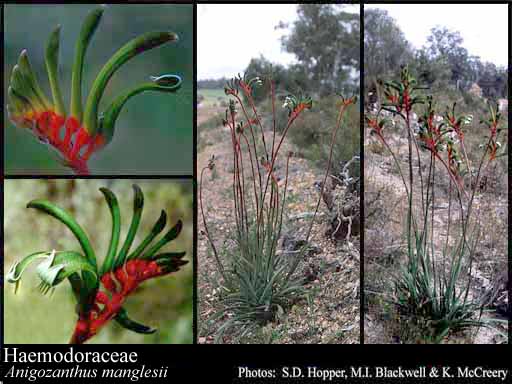- Reference
- Prodr.Fl.Nov.Holland. 299 (1810)
- Name Status
- Current







Scientific Description
Common name. Bloodroot Family.
Habit and leaf form. Herbs; with coloured juice, or non-laticiferous and without coloured juice. Perennial; plants with a basal concentration of leaves (leaves all radical); rhizomatous, or tuberous, or bulbaceous. Rhizome and root tissues brightly red-pigmented (often, and pigment present throughout the plant in Haemodorum), or not red-pigmented. Mesophytic, or xerophytic. Leaves medium-sized to large; alternate; distichous; leathery; sessile; sheathing. Leaf sheaths with free margins. Leaves edgewise to the stem (usually), or with ‘normal’ orientation; simple; epulvinate. Leaf blades entire; linear (or ensiform); parallel-veined. Leaf blade margins entire. Leaves with a persistent basal meristem, and basipetal development. Vernation conduplicate. Leaf anatomy. Guard-cells not ‘grass type’. Stem anatomy. Secondary thickening absent.
Reproductive type, pollination. Fertile flowers hermaphrodite. Unisexual flowers absent. Plants hermaphrodite. Floral nectaries present. Nectar secretion from the gynoecium (via septal nectaries). Entomophilous, or ornithophilous, or pollinated by unusual means (occasionally by small mammals).
Inflorescence and flower features. Flowers aggregated in ‘inflorescences’ (usually), or solitary; in cymes, in panicles, and in racemes. The terminal inflorescence unit cymose, or racemose. Inflorescences scapiflorous (usually, the inflorescence and flowers often woolly-hairy); terminal; panicles, thyrses with cymose lateral branches, or racemes. Flowers regular to very irregular; when irregular, zygomorphic; 3 merous; cyclic; tricyclic, or tetracyclic. Perigone tube present (straight or curved), or absent. Perianth of ‘tepals’; 6; 2 -whorled (when free, Haemodoroideae), or 1 -whorled (when tubular, Conostyloideae); isomerous; petaloid; similar in the two whorls; green, or white, or cream, or yellow, or orange, or red, or violet, or black. Androecium 3, or 6. Androecial members adnate (to the perianth lobes, or to the inner perianth segments); all equal; free of one another; 1 -whorled, or 2 -whorled. Androecium exclusively of fertile stamens. Stamens 3, or 6; isomerous with the perianth, or diplostemonous; alterniperianthial, or oppositiperianthial (in three-stamened Haemodoroideae, where the outer whorl is missing). Filaments appendiculate (e.g. Tribonanthes), or not appendiculate. Anthers dorsifixed, or basifixed; versatile, or non-versatile; dehiscing via longitudinal slits; introrse; unappendaged, or appendaged (apically, from the connective). Gynoecium 3 carpelled. The pistil 3 celled. Gynoecium syncarpous; eu-syncarpous; superior to inferior. Ovary plurilocular; 3 locular. Gynoecium stylate. Styles 1, or 3; when 3, partially joined; attenuate from the ovary, or from a depression at the top of the ovary; apical; much longer than the ovary at anthesis (usually filiform). Stigmas 1, or 3; capitate; wet type, or dry type; papillate; Group II type, or Group III type. Placentation axile. Ovules 1–50 per locule (i.e. to ‘many’); non-arillate; orthotropous to hemianatropous.
Fruit and seed features. Fruit non-fleshy; dehiscent, or indehiscent; a capsule, or a nut (Phlebocaryeae). Capsules loculicidal, or valvular (Macropdia). Seeds copiously endospermic. Endosperm oily. Seeds winged (Haemodorum), or wingless; with starch. Cotyledons 1. Testa without phytomelan. Seedling. Hypocotyl internode present. Mesocotyl absent. Seedling collar not conspicuous. Cotyledon hyperphyll elongated, or compact; assimilatory, or non-assimilatory; more or less circular in t.s. Coleoptile absent. First leaf ensiform. Primary root ephemeral.
Geography, cytology, number of species. World distribution: South Africa, Australia, New Guinea, Southeast U.S.A., Central America, tropical South America. X = 4–8, or 15 (or more). 75 species.
Keys
Key to the Haemodoraceae of Western Australia
C. Hollister, K.R. Thiele